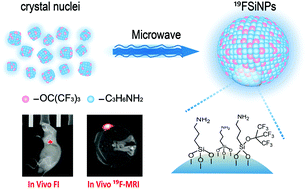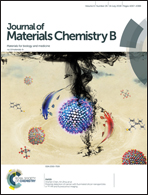Potential detection of cancer with fluorinated silicon nanoparticles in 19F MR and fluorescence imaging†
Abstract
Fluorescence is widely used for cell imaging due to its high sensitivity and rich color choices but limited for in vivo imaging because of its low light penetration. Meanwhile, magnetic resonance imaging (MRI) is widely applied for in vivo diagnosis but not suitable for cell imaging because of its low resolution. As a result of rare background in living organisms, 19F-MRI stands out in several fields of clinical application. Herein, we report a one-pot microwave synthesis of fluorinated silicon nanoparticles (19FSiNPs), for detection of cancer cells and tumors. Based on the quantum effects of the nano-sized nanoparticles, 19FSiNPs can act as a label free dye for ultracontrast cell fluorescence imaging. Our experiments demonstrated that these nanoprobes significantly enhanced in vivo19F/1H MRI contrast in rats with non-small cell lung tumors. Moreover, the resulting 19FSiNPs exhibited high water dispersibility and excellent biocompatibility, which make them promising for both cell imaging and in vivo imaging applications.



 Please wait while we load your content...
Please wait while we load your content...